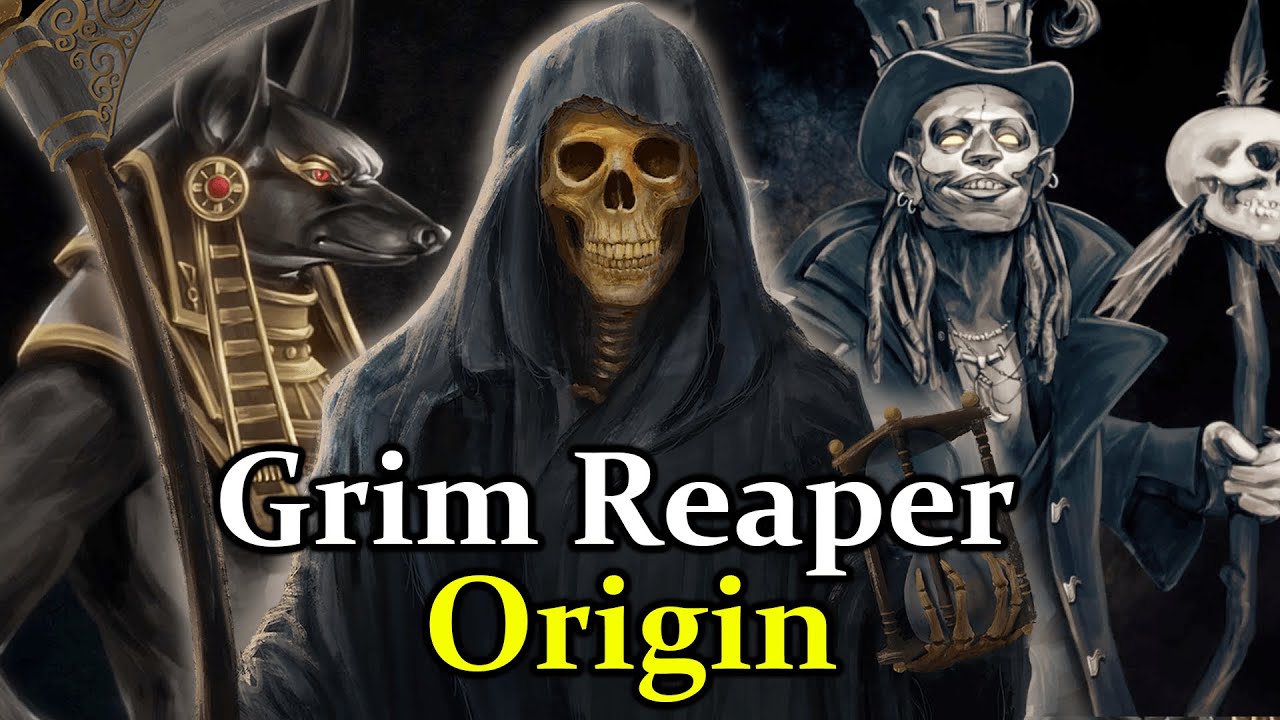“The History and Origin of the Grim Reaper” is a video that aims to uncover the fascinating backstory behind this iconic figure associated with death. The video explores the Grim Reaper’s image and symbolism, tracing its roots back to the 14th-century plague and the need for a recognizable symbol during a time of high mortality. It also delves into different cultures and mythologies, highlighting various deities and spirits of death from around the world. The video encourages viewers to like and join the channel for exclusive perks, as well as check out the accompanying podcast for further exploration. So, if you’ve ever wondered about the origins of the Grim Reaper and the diverse personifications of death across different cultures and mythologies, this video is sure to provide a captivating and educational experience.
The Emergence of the Grim Reaper
During the 14th Century Plague
Throughout history, death has been a concept that both fascinates and terrifies us. In times of immense suffering and loss, such as the devastating 14th-century plague known as the Black Death, the personification of death becomes more prevalent in art, literature, and folklore. This was the era in which the Grim Reaper began to emerge as a symbol of mortality and the inevitability of death.
Symbolism of Death and Mortality
Death, as a universal and inevitable part of life, is a concept that has been interpreted and symbolized in various ways across different cultures and time periods. The Grim Reaper, as a personification of death, embodies the fear, mystery, and finality associated with the end of life. From ancient mythology to contemporary popular culture, the symbolism of death and mortality continues to captivate and haunt our collective imagination.
Historical and Cultural Personifications of Death
Thanatos in Greek Mythology
In Greek mythology, death was personified by Thanatos, the son of Nyx (night) and Erebus (darkness). Thanatos was often depicted as a gentle figure with wings, guiding the souls of the deceased to the afterlife. Unlike the Grim Reaper, Thanatos was not portrayed as a fearsome figure, but rather as a compassionate escort to the realm of the dead.
Hades, Hermes, and Persephone in Greek Mythology
While Thanatos represented the natural process of dying, Hades, the god of the underworld, played a more significant role in the afterlife. Hades, along with Hermes, the messenger of the gods, and Persephone, the queen of the underworld, were responsible for judging souls and determining their fate in the realm of the dead. These mythological figures held power over life and death, ensuring the order and balance of the mortal and immortal realms.
Other Death Deities and Spirits
Beyond Greek mythology, various cultures around the world have their own personifications of death. In Norse mythology, the Valkyries were female figures who chose which warriors would die in battle and escorted them to the afterlife. The Aztecs had Mictlantecuhtli and Mictecacihuatl, the lord and lady of the underworld, who ruled over the dead. These different personifications serve as a reminder of our shared fascination with death and the complexities of our beliefs and attitudes towards mortality.
The Grim Reaper in Western Culture
The Iconic Image of the Grim Reaper
When we picture the Grim Reaper, we envision a skeletal figure cloaked in dark robes, clutching a menacing scythe. This iconic image has become synonymous with death and has embedded itself in Western culture. The skeletal appearance emphasizes the decay and inevitability of the physical body, while the dark robes and hood enhance the air of mystery and anonymity surrounding death.
Symbolism of the Skeleton, Dark Robes, and Scythe
The skeleton, stripped of flesh and muscle, represents the ultimate transformation of the human body after death. It serves as a stark reminder of the impermanence and fragility of life. The dark robes, often black or deep purple, symbolize the unknown and the uncharted territory of the afterlife. As for the scythe, it represents the severing of life and the harvesting of souls, echoing the agricultural origins of our understanding of death.

Mythological and Folklore Origins
Grim Reaper in European Folklore
The origins of the Grim Reaper can be traced back to European folklore. In these tales, a spectral figure dressed in black would appear to foretell the imminent death of an individual, sometimes even materializing to physically claim their soul. This figure was known by different names, such as Ankou in Celtic folklore or the Black Annis in English folktales. Such folklore highlights the psychological impact of death on communities and their efforts to understand and cope with mortality.
Influence of Celtic and Germanic Mythologies
Celtic and Germanic mythologies played a substantial role in shaping the personification of death in Western folklore. In Celtic mythology, the veil between the living and the dead was believed to be thinner during Samhain, a festival that eventually evolved into Halloween. This concept of liminality and the presence of supernatural beings during moments of transition influenced the image of the Grim Reaper. Germanic mythologies, on the other hand, featured deities associated with death and the afterlife, such as Hel and the god Odin, who were often depicted with attributes that later became associated with the Grim Reaper.
The Grim Reaper in Art and Literature
Depictions in Paintings and Sculptures
The image of the Grim Reaper has been brought to life in countless artistic representations throughout history. Paintings and sculptures often depict the Grim Reaper as a haunting figure gliding through graveyards or looming over the dying. These visual depictions capture the fear and fascination that death evokes, as well as the cultural, religious, and societal beliefs of the time.
Representation in Literature and Poetry
The Grim Reaper has also found its place in literature and poetry, with writers using the imagery of death to delve into the existential and emotional depths of the human experience. From Shakespeare’s Hamlet to Edgar Allan Poe’s “The Masque of the Red Death,” the Grim Reaper serves as a potent symbol, causing readers to ponder the mysteries of life, mortality, and the inevitability of our own demise.
The Grim Reaper in Popular Culture
Depictions in Movies and TV Shows
As popular culture evolved, the Grim Reaper became a recurring character in movies and TV shows, often portrayed as a supernatural being tasked with guiding souls to the afterlife or as a personification of death itself. Films like “The Seventh Seal” and “Monty Python’s The Meaning of Life” explore the existential themes surrounding death, while TV shows like “Supernatural” and “American Horror Story” present the Grim Reaper as a formidable figure in the supernatural realm.
Influence on Halloween and Gothic Subculture
The striking image of the Grim Reaper has had a significant impact on the celebration of Halloween and the development of the gothic subculture. Halloween, with its focus on death and the macabre, draws inspiration from the fear and fascination associated with mortality, often featuring the Grim Reaper as a prominent symbol. Similarly, the gothic subculture, with its dark aesthetics and exploration of death and melancholy, finds affinity in the imagery and symbolism of the Grim Reaper.
Different Personifications of Death in Other Cultures
Mexican and South American Deities of Death
In Mexican and South American cultures, death is personified by deities such as Mictlantecuhtli and Mictecacihuatl in Aztec mythology, and Santa Muerte in contemporary Mexican folklore. These figures are often depicted with a mix of Catholic and indigenous symbolism and are revered for their role in guiding and protecting souls during the journey to the afterlife.
Haitian Spirits of Death
In Haitian Vodou, death is personified by the spirits known as Baron Samedi and Maman Brigitte. Baron Samedi, often depicted as a skeletal figure wearing a top hat, is the guardian of the cemetery and assists the souls of the deceased. Maman Brigitte is associated with death and healing, embodying both the nurturing and destructive aspects of the cycle of life.
Chinese and Japanese Personifications
Chinese and Japanese cultures have their own personifications of death. In Chinese mythology, Yanluo Wang, also known as King Yama, presides over the underworld and judges the souls of the deceased. On the other hand, Yama, the god of death in Japanese Buddhism, plays a similar role in determining the destiny of the deceased, often depicted with a fierce and wrathful appearance.
Egyptian Gods and Goddesses of Death
In Ancient Egypt, death was intricately woven into the religious and spiritual beliefs of the civilization. Gods such as Anubis, often depicted with the head of a jackal, and Osiris, who governed the afterlife, were central figures in the Egyptian pantheon. They held roles in guiding and preserving the souls of the deceased, as well as playing a part in the mythology surrounding death and rebirth.
Role and Symbolism of Death Personifications
Guiding Souls to the Afterlife
One of the primary roles of death personifications across cultures is to guide souls to the afterlife. They act as intermediaries between the world of the living and the realm of the dead, ensuring a smooth transition for the deceased. Whether it is the Grim Reaper, Thanatos, or another deity, this role symbolizes the importance of acknowledging and respecting the journey of the soul beyond physical existence.
Judging the Dead and Consequences
Death personifications often play a role in judging the souls of the deceased and determining their fate in the afterlife. This aspect reflects the belief in cosmic justice and the consequences of one’s actions in life. Whether it is Hades in Greek mythology or King Yama in Chinese mythology, these figures uphold the moral order and accountability for one’s deeds, providing a sense of closure and justice in the face of mortality.
Comfort and Explanation during High Mortality
In times of high mortality, death personifications serve as a source of comfort and explanation for the unexplainable. As communities grapple with the loss of loved ones, these figures provide a framework for understanding and accepting death. They offer solace by reminding individuals that death is a natural part of the cycle of life and that there are forces beyond human control at play.
The Grim Reaper in Modern Society
Continued Symbolism and Use in Art and Media
Despite the advancements in science and technology, the Grim Reaper continues to hold a prominent place in modern society’s portrayal of death. The iconic imagery of the skeletal figure, dark robes, and scythe remains a powerful symbol of mortality and our primal fear of the unknown. The Grim Reaper’s pervasive presence in art, media, and popular culture reflects society’s ongoing fascination, fascination, and introspection on the concept of death.
Perception and Fear of Death in Contemporary Culture
The Grim Reaper’s enduring presence in modern society is a testament to our complex relationship with death. Rather than shying away from this inevitable aspect of life, the symbolism of the Grim Reaper encourages contemplation on mortality and the transient nature of existence. It serves as a reminder to seize the present moment and live life to its fullest, while also acknowledging the fear and uncertainty that come with the prospect of our own mortality.
Conclusion
The emergence of the Grim Reaper as a personification of death during the 14th-century plague marked a turning point in Western culture’s fascination with mortality. From ancient mythologies to contemporary popular culture, the symbolism and imagery associated with death personifications transcend time and cultures. Whether depicted as a fearsome figure or a compassionate guide, these personifications serve as mirrors reflecting our deep-seated philosophical, religious, and emotional contemplation on life’s one inevitable certainty: death.
